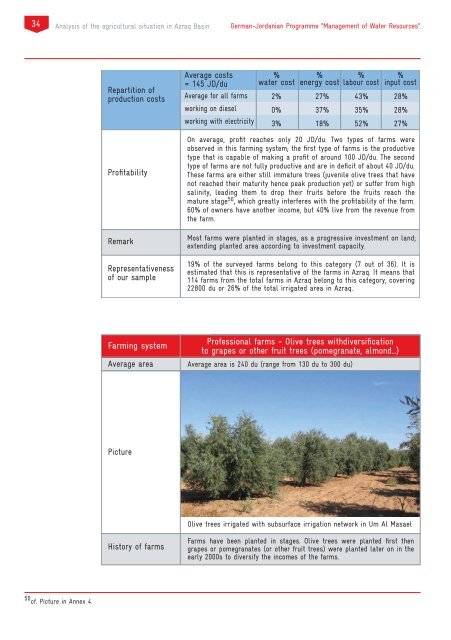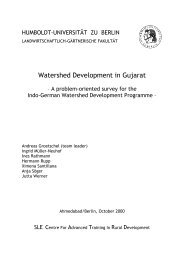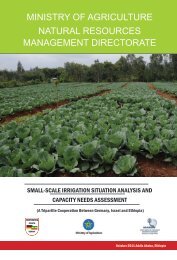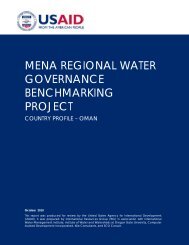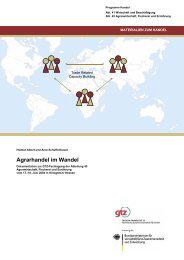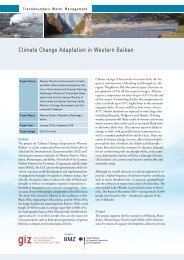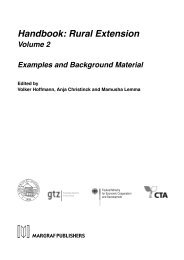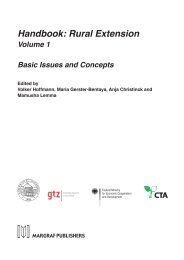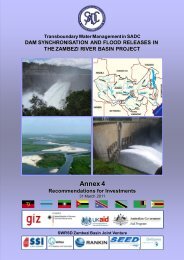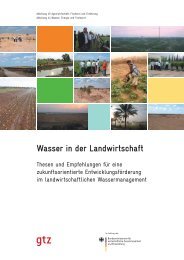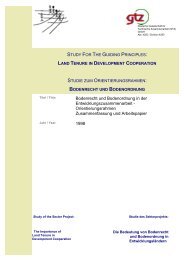Farming in the - WordPress.com
Farming in the - WordPress.com
Farming in the - WordPress.com
You also want an ePaper? Increase the reach of your titles
YUMPU automatically turns print PDFs into web optimized ePapers that Google loves.
34<br />
Analysis of <strong>the</strong> agricultural situation <strong>in</strong> Azraq Bas<strong>in</strong><br />
German-Jordanian Programme “Management of Water Resources”<br />
<strong>Farm<strong>in</strong>g</strong> system<br />
Repartition of<br />
production costs<br />
Profitability<br />
Remark<br />
Representativeness<br />
of our sample<br />
Average costs<br />
= 145 JD/du<br />
Average for all farms<br />
work<strong>in</strong>g on diesel<br />
Professional farms – Specialised olive tree farm<br />
work<strong>in</strong>g with electricity<br />
%<br />
water cost<br />
%<br />
energy cost<br />
%<br />
labour cost<br />
%<br />
<strong>in</strong>put cost<br />
2% 27% 43% 28%<br />
0% 37% 35% 28%<br />
3% 18% 52% 27%<br />
On average, profit reaches only 20 JD/du. Two types of farms were<br />
observed <strong>in</strong> this farm<strong>in</strong>g system; <strong>the</strong> first type of farms is <strong>the</strong> productive<br />
type that is capable of mak<strong>in</strong>g a profit of around 100 JD/du. The second<br />
type of farms are not fully productive and are <strong>in</strong> deficit of about 40 JD/du.<br />
These farms are ei<strong>the</strong>r still immature trees (juvenile olive trees that have<br />
not reached <strong>the</strong>ir maturity hence peak production yet) or suffer from high<br />
sal<strong>in</strong>ity, lead<strong>in</strong>g <strong>the</strong>m to drop <strong>the</strong>ir fruits before <strong>the</strong> fruits reach <strong>the</strong><br />
mature stage 50 , which greatly <strong>in</strong>terferes with <strong>the</strong> profitability of <strong>the</strong> farm.<br />
60% of owners have ano<strong>the</strong>r <strong>in</strong><strong>com</strong>e, but 40% live from <strong>the</strong> revenue from<br />
<strong>the</strong> farm.<br />
Most farms were planted <strong>in</strong> stages, as a progressive <strong>in</strong>vestment on land;<br />
extend<strong>in</strong>g planted area accord<strong>in</strong>g to <strong>in</strong>vestment capacity.<br />
19% of <strong>the</strong> surveyed farms belong to this category (7 out of 36). It is<br />
estimated that this is representative of <strong>the</strong> farms <strong>in</strong> Azraq. It means that<br />
114 farms from <strong>the</strong> total farms <strong>in</strong> Azraq belong to this category, cover<strong>in</strong>g<br />
22800 du or 26% of <strong>the</strong> total irrigated area <strong>in</strong> Azraq.<br />
<strong>Farm<strong>in</strong>g</strong> system<br />
Average area<br />
Professional farms - Olive trees withdiversification<br />
to grapes or o<strong>the</strong>r fruit trees (pomegranate, almond…)<br />
Average area is 240 du (range from 130 du to 300 du)<br />
Picture<br />
Olive trees irrigated with subsurface irrigation network <strong>in</strong> Um Al Masael<br />
History of farms<br />
Farms have been planted <strong>in</strong> stages. Olive trees were planted first <strong>the</strong>n<br />
grapes or pomegranates (or o<strong>the</strong>r fruit trees) were planted later on <strong>in</strong> <strong>the</strong><br />
early 2000s to diversify <strong>the</strong> <strong>in</strong><strong>com</strong>es of <strong>the</strong> farms.<br />
50 cf. Picture <strong>in</strong> Annex 4.


